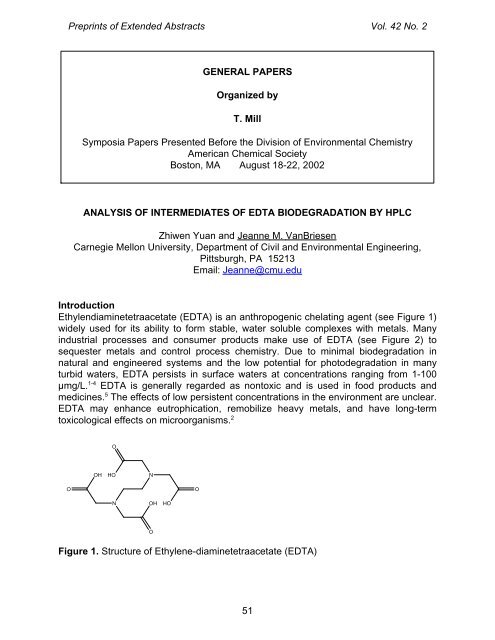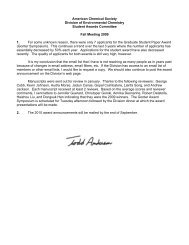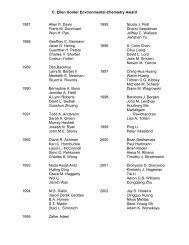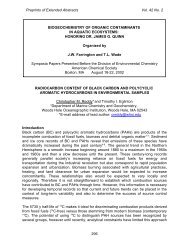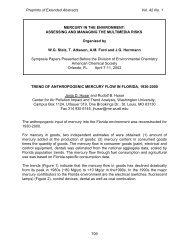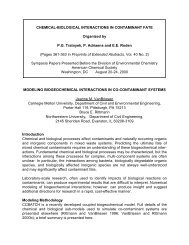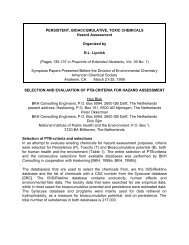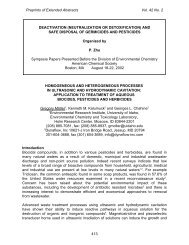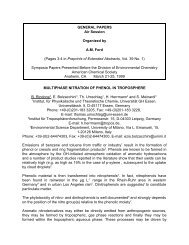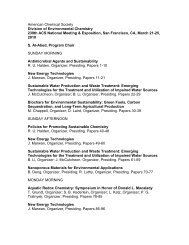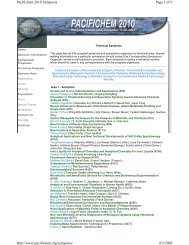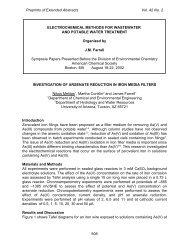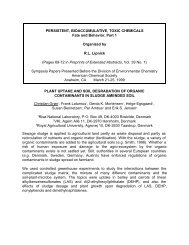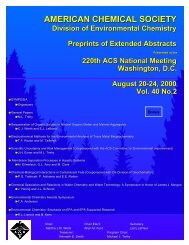paper 112 - ACS: Division of Environmental Chemistry
paper 112 - ACS: Division of Environmental Chemistry
paper 112 - ACS: Division of Environmental Chemistry
You also want an ePaper? Increase the reach of your titles
YUMPU automatically turns print PDFs into web optimized ePapers that Google loves.
Preprints <strong>of</strong> Extended Abstracts Vol. 42 No. 2<br />
ANALYSIS OF INTERMEDIATES OF EDTA BIODEGRADATION BY HPLC<br />
Zhiwen Yuan and Jeanne M. VanBriesen<br />
Carnegie Mellon University, Department <strong>of</strong> Civil and <strong>Environmental</strong> Engineering,<br />
Pittsburgh, PA 15213<br />
Email: Jeanne@cmu.edu<br />
Introduction<br />
Ethylendiaminetetraacetate (EDTA) is an anthropogenic chelating agent (see Figure 1)<br />
widely used for its ability to form stable, water soluble complexes with metals. Many<br />
industrial processes and consumer products make use <strong>of</strong> EDTA (see Figure 2) to<br />
sequester metals and control process chemistry. Due to minimal biodegradation in<br />
natural and engineered systems and the low potential for photodegradation in many<br />
turbid waters, EDTA persists in surface waters at concentrations ranging from 1-100<br />
µmg/L. 1-4 EDTA is generally regarded as nontoxic and is used in food products and<br />
medicines. 5 The effects <strong>of</strong> low persistent concentrations in the environment are unclear.<br />
EDTA may enhance eutrophication, remobilize heavy metals, and have long-term<br />
toxicological effects on microorganisms. 2<br />
O<br />
OH<br />
O<br />
HO<br />
N<br />
N<br />
OH<br />
O<br />
HO<br />
Figure 1. Structure <strong>of</strong> Ethylene-diaminetetraacetate (EDTA)<br />
O<br />
GENERAL PAPERS<br />
Organized by<br />
T. Mill<br />
Symposia Papers Presented Before the <strong>Division</strong> <strong>of</strong> <strong>Environmental</strong> <strong>Chemistry</strong><br />
American Chemical Society<br />
Boston, MA August 18-22, 2002<br />
51
Preprints <strong>of</strong> Extended Abstracts Vol. 42 No. 2<br />
Water<br />
Agro<br />
Chemicals -<br />
5%<br />
Textiles - 6%<br />
Other - 16%<br />
Treatment - 1%<br />
Paper<br />
Products - 7%<br />
Photo Industry -<br />
17%<br />
Industrial<br />
Detergents -<br />
32%<br />
Household<br />
Detergents -<br />
16%<br />
Figure 2. Uses <strong>of</strong> EDTA (following Frimmel, 1997 1 )<br />
Biodegradation <strong>of</strong> EDTA is a potential mode <strong>of</strong> removal from the environment. DSM<br />
6780, an EDTA degrading organism isolated by Nortemann, 6 initiates EDTA<br />
biodegradation but does not mineralize it. Instead, intermediates are produced that<br />
have significant chelation ability. Intermediates formed in the biodegradation <strong>of</strong> EDTA<br />
include ethylendiaminetriacetic acid (ED3A), 2-oxo-1,4-piperazinediacetic acid (3KP),<br />
N,N’-ethylenediaminediacetic acid (N,N’-EDDA), iminodiacetic acid (IDA), and<br />
glycine. 7-11 If these intermediates persist, they sequester carbon and electrons,<br />
reducing cell yield and slowing the rate <strong>of</strong> removal <strong>of</strong> EDTA from the system.<br />
EDTA intermediates were previously analyzed by Kluner et al 7 with ED3A and 3KP<br />
measured simultaneously and N,N’ EDDA measured on a separate column. Witschel et<br />
al 12 and Sorensen 13 use a method similar to Kluner. Glycine has been measured by<br />
Einarsson et al 14 as an amino acid with HPLC with fluorescence detection. IDA has<br />
been previously measured using fluorescence detection as well. 15 The contribution <strong>of</strong><br />
this work was to develop a method for concurrent measurement <strong>of</strong> ED3A, N, N’EDDA<br />
and 3KP and concurrent measurement <strong>of</strong> IDA and glycine. The new methods also rely<br />
on a UV detector, which although less sensitive than a fluorescence detector, still<br />
allows detection to 10 -7 M for these intermediates.<br />
Materials and Methods<br />
The HPLC was performed with a Quaternary HP 1050 Pump and HP 1050 Series<br />
Variable Wavelength UV/Visible Detector. The manual injector (Model 7125,<br />
Rheodyne) was equipped with a sample loop <strong>of</strong> 20ml. Nucleosil 100-5 C18 Column<br />
(Agilent Technologies), 250 mm in length, 4.0 mm in diameter with a particle size <strong>of</strong> 5<br />
mm, was used for both methods. HP Chemstation s<strong>of</strong>tware (Reversion A.07.01,<br />
Hewlett-Packard) was used for chromatogram integration and linear regression <strong>of</strong><br />
calibration table and curve. The calculation <strong>of</strong> concentrations was based on peak area.<br />
Because copper complexes <strong>of</strong> N,N’-EDDA, ED3A and 3KP are very stable, they were<br />
concurrently measured by ion-pair reversed-phased HPLC after complexation with<br />
52
Preprints <strong>of</strong> Extended Abstracts Vol. 42 No. 2<br />
excess copper acetate. The ion-pair reagent is dodecyltrimethyl ammonium bromide.<br />
The chromatography are as following. Mobile phase: 1mM copper acetate, 0.6g/L<br />
dodecyltrimethyl ammonium bromide, 5 µl/l CH3COOH, and finally pH adjusted to 5.4<br />
with NaOH solution. Flow rate: 1.0 ml/min. Detection wavelength: 280nm. Injection<br />
volume: 20 µl. All three intermediates were separated within 7 min.<br />
IDA and glycine were measured as amino acids after derivatization with<br />
9-fluorenylmethyl chlor<strong>of</strong>ormate (FMOC-Cl). The reaction <strong>of</strong> FMOC-Cl with the amino<br />
acids proceeds as follows under basic conditions:<br />
H 2C O C<br />
O<br />
+ H2N C C H<br />
Cl<br />
H<br />
H<br />
O<br />
H 2C O C<br />
O<br />
H<br />
+ H +<br />
O<br />
NH C<br />
H<br />
C H<br />
+ Cl -<br />
The derivatives are highly fluorescent and stable. The fluorescent derivatives with<br />
FMOC-Cl can be monitored by fluorescence detector or ultraviolet (UV) detector. The<br />
separation was carried out by gradient elution under room temperature. The mobile<br />
phase was made by mixing elution buffer solution and acetonitrile-water solution. The<br />
elution buffer is made by adding 3ml/l glacial acetic acid in deionized water and<br />
adjusted to pH 4.3 with NaOH solution. The acetonitrile-water solution contained 70%<br />
acetonitrile (v/v). The gradient elution immediately began after sample injection, and<br />
the eluent varied linearly from 40% acetonitrile-water solution to 70% acetonitrile-water<br />
solution in 8min. The flowrate was 1.2ml and the whole elution ended at 12 min. The<br />
detection wavelength is 280 nm.<br />
Results and Discussion<br />
The representative chromatograph for separation <strong>of</strong> N,N’ EDDA, ED3A, and 3KP is<br />
shown in Figure 3. This is the first report <strong>of</strong> concurrent measurement <strong>of</strong> these EDTA<br />
biodegradation intermediates. The representative chromatogram for separation <strong>of</strong> IDA<br />
and glycine is shown in Figure 4. This is the first report <strong>of</strong> concurrent measurement <strong>of</strong><br />
these intermediates and the use <strong>of</strong> UV rather than fluorescence detection.<br />
The detection limits <strong>of</strong> these five intermediates are all below 10 -7 M, which are low<br />
enough for most applications involving biodegradation <strong>of</strong> EDTA. The detection limit can<br />
be lowered by increasing the injection volume. These two HPLC methods are simple,<br />
fast, accurate, specific, and applicable to the analysis <strong>of</strong> these intermediates in<br />
different matrixes.<br />
53
Preprints <strong>of</strong> Extended Abstracts Vol. 42 No. 2<br />
mAU<br />
5<br />
4<br />
3<br />
2<br />
1<br />
0<br />
-1<br />
VWD1 A, Wavelength=280 nm (YUAN\80700003.D)<br />
2.616<br />
Area: 19.5348<br />
N,N'-EDDA<br />
Area: 25.0715<br />
0 1 2 3 4 5 6<br />
ED3A<br />
5.491<br />
5.974<br />
Area: 26.6155<br />
Figure 3. Chromatogram <strong>of</strong> N,N’-EDDA, ED3A and 3KP (10mM for each compound)<br />
mAU<br />
8<br />
6<br />
4<br />
2<br />
0<br />
VWD1 A, Wavelength=280 nm (YUAN\80600004.D)<br />
4.514<br />
Area: 56.4618<br />
IDA<br />
0 2 4 6 8 10<br />
6.449<br />
Area: 43.5847<br />
glycine<br />
Figure 4. Chromatogram <strong>of</strong> 10 mM IDA and 10 mM glycine<br />
10.450<br />
3KP<br />
Area: 46.0853<br />
FMOC-OH<br />
References<br />
1. Frimmel, F. Physiochemical properties <strong>of</strong> ethylene dinitrilotetraacetic acid and<br />
consequences for its distribution in the aquatic environment. IN: Detergents in the<br />
Environment; Schwager, M., Editor; Marcel Dekker Inc.: New York, 1997; pp<br />
289-312.<br />
2. Sillanpaa, M. <strong>Environmental</strong> fate <strong>of</strong> EDTA and DTPA. Reviews in <strong>Environmental</strong><br />
Contaminant Toxicology 1997, 152, 85-111.<br />
3. Barber, L.; Brown, G.; Zaugg, S. Potential endocrine disrupting organic chemicals<br />
in treated municipal wastewater and river water, Upper Midwest, USA. IN: Analysis<br />
<strong>of</strong> <strong>Environmental</strong> Endocrine Disruptors, American Chemical Society Symposium<br />
Series No. 747; Keith, L.; Jones-Lepp, T.; Needham, L., Editors; American<br />
Chemical Society: Washington DC, 1999.<br />
4. Sacher, F.; Lochow, E.; Brauch, H.-J. Synthetic Organic Complexing Agents --<br />
54<br />
min<br />
min
Preprints <strong>of</strong> Extended Abstracts Vol. 42 No. 2<br />
Analysis and Occurrence in Surface Waters. Vom Wasser 1998, 90, 31-41.<br />
5. Othmer, K. Encyclopedia <strong>of</strong> Chemical Technology, 4th ed.; Krosihwitz, J. I., editor;<br />
John Wiley and Sons: New York, 1993; Vol. 5, pp 764-795.<br />
6. Nortemann, B. Total Degradation <strong>of</strong> EDTA by Mixed Cultures and a Bacterial<br />
Isolate. Applied and <strong>Environmental</strong> Microbiology 1992, 58(2), 671-676.<br />
Notes: have copy<br />
7. Kluner, T.; Hempel, D. C.; Nortemann, B. Metabolism <strong>of</strong> EDTA and its metal<br />
chelates by whole cells and cell-free extracts <strong>of</strong> strain BNC1. Applied Microbiology<br />
and Biotechnology 1998, 49, 194-201.<br />
8. Nortemann, B. Mini-Review: Biodegradation <strong>of</strong> EDTA. Applied Microbiology and<br />
Biotechnology 1999, 51, 751-759.<br />
9. Bohuslavek, J.; Payne, J. W.; Liu, Y.; Bolton, H. Jr.; Xun, L. Cloning, sequencing<br />
and characterization <strong>of</strong> a gene cluster involved in EDTA degradation from the<br />
bacterium BNC1. Applied and <strong>Environmental</strong> Microbiology 2001, 67(2), 688-95.<br />
10. Liu, Y.; Louie, T. M.; Payne, J.; Bohuslavek, J.; Bolton, H. Jr.; Xun, L. Identification,<br />
purification, and characterization <strong>of</strong> Iminodiacetate oxidase from the EDTA<br />
degrading bacterium BNC1. Applied and <strong>Environmental</strong> Microbiology 2001, 67(2),<br />
696-701.<br />
11. Payne, J.; Bolton, H. Jr.; Campbell, J. X. L. Purification and Characterization <strong>of</strong><br />
EDTA Monooxygenase from the EDTA Degrading Bacterium BNC1. Journal <strong>of</strong><br />
Bacteriology 1998, 180(15), 3823-3827.<br />
12. Witschel, M.; Nagel, S.; Egli, T. Identification and characterization <strong>of</strong> the<br />
two-enzyme system catalyzing oxidation <strong>of</strong> EDTA in the EDTA-Degrading bacterial<br />
strain DSM 9103. Journal <strong>of</strong> Bacteriology 1997, 179(22), 6937-6943.<br />
13. Sorensen, M. Universitat Karlsruhe, 1996.<br />
14. Einarsson, S.; Joseffsson, B.; Lagerkvist, S. Determination <strong>of</strong> Amino Acids with<br />
9-Fluorenylmethyl Chlor<strong>of</strong>ormate and Reversed-Phase High-Performance Liquid<br />
Chromatography. Journal <strong>of</strong> Chromatography 1983, 282, 609-18.<br />
15. Bolton, H. Jr.; Girvin, D. C.; Plymale, A. E.; Harvey, S. D.; Workman, D. J.<br />
Degradation <strong>of</strong> Metal-Nitrilotriacetate (NTA) Complexes by Chelatobacter heintzii.<br />
<strong>Environmental</strong> Science and Technology 1996, 30(3), 931-938.<br />
55


